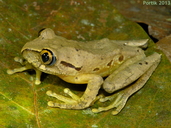|
Leptopelis calcaratus (Boulenger, 1906)
| family: Arthroleptidae genus: Leptopelis |
 © 2013 Daniel Portik (1 of 13) |
|
|
|
Description Laurent has established two very similar subspecies: (1) L. c. calcaratus from Eastern Nigeria, Cameroun and R. D. Congo north of Congo River: Spur on heel well developed, webbing less developed. (2) L. c. meridionalis Laurent 1973 from the forests of R. D. Congo south of Congo River, spur on heel less developed, webbing more extensive. There are other small morphological differences between the two. The tadpole has the typical Leptopelis appearance and reaches a maximum length of 56 mm (17+39). The smallest tadpoles have a tooth formula of 1,1+1/ 3, older tadpoles 1,2+2/ 3 and the largest the typical formula of 1,3+3/3. Distribution and Habitat Country distribution from AmphibiaWeb's database: Cameroon, Central African Republic, Congo, Congo, the Democratic Republic of the, Equatorial Guinea, Gabon, Nigeria, Uganda
Life History, Abundance, Activity, and Special Behaviors Comments
References
Schiøtz, A. (1999). Treefrogs of Africa. Edition Chimaira, Frankfurt am Main. Originally submitted by: Arne Schiøtz (first posted 2001-01-31) Edited by: Kellie Whittaker (2008-01-18) Species Account Citation: AmphibiaWeb 2008 Leptopelis calcaratus <https://amphibiaweb.org/species/3643> University of California, Berkeley, CA, USA. Accessed May 12, 2025.
Feedback or comments about this page.
Citation: AmphibiaWeb. 2025. <https://amphibiaweb.org> University of California, Berkeley, CA, USA. Accessed 12 May 2025. AmphibiaWeb's policy on data use. |



 Map of Life
Map of Life